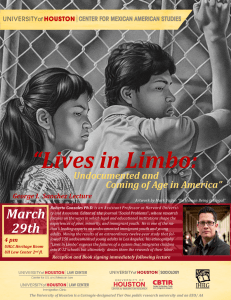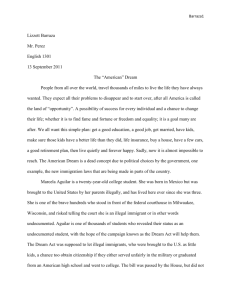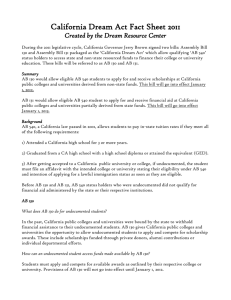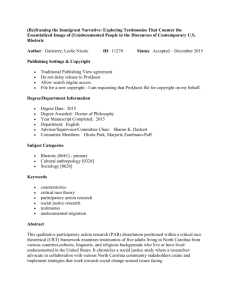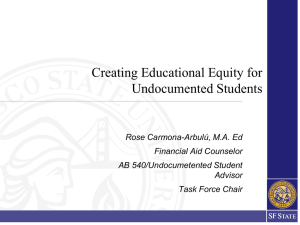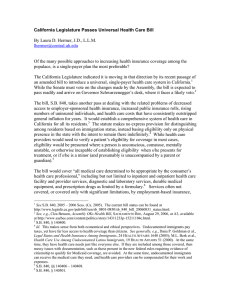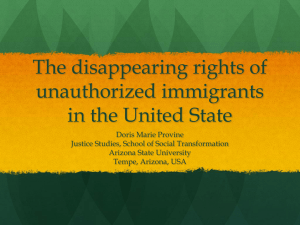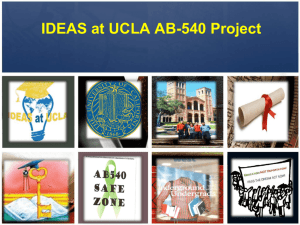Document 10868917
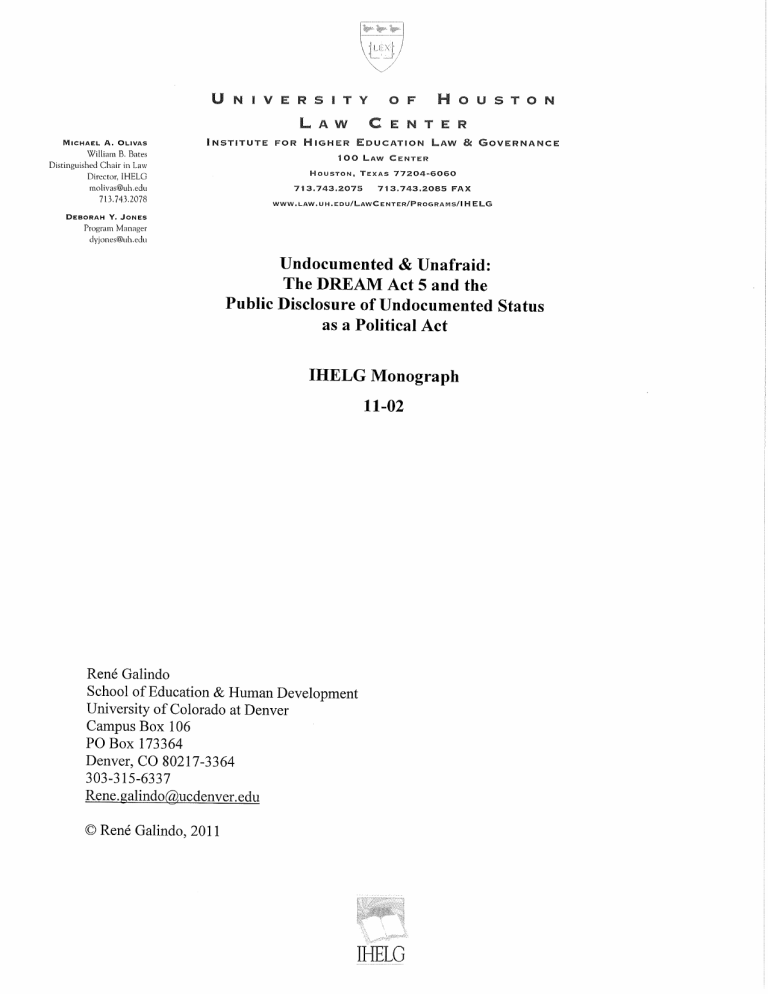
Undocumented & Unafraid:
The DREAM Act 5 and the Public Disclosure of Undocumented Status as a Political Act
The DREAM Act 5 in Senator McCain’s office (5-17-2010)
DRAFT
(Please do not cite without the author’s permission)
René Galindo
School of Education & Human Development
University of Colorado at Denver
Campus Box 106
PO Box 173364
Denver, CO 80217-3364
303-315-6337
Rene.galindo@ucdenver.edu
1
Undocumented & Unafraid:
The DREAM Act 5 and the Public Disclosure of Undocumented Status as a Political Act
Abstract
The political advocacy of undocumented students was apparent during 2010 through demonstrations across the country in support of the DREAM Act. Among those demonstrations was the national Coming Out of the Shadows event held in Chicago in
March 10 where students publicly disclosed their undocumented status as part of the
Undocumented & Unafraid campaign. On May 17 a historic even occurred when five students, now known as the DREAM Act 5, practiced civil disobedience by staging a sitin inside Senator McCain’s office in Tucson. Three of the students arrested were undocumented immigrants. The present study examines the public disclosure of undocumented status as political act on the part of undocumented students. Letters written by four of the DREAM Act 5 to the president, press media reports and interviews, and information from student advocacy blogs were examined. The primary data source, the students’ letters, were considered testimonios since they contained the students’ coming out statements, their migration stories, explanations of their civil disobedience, and appeals for President Obama’s support of the DREAM Act. The analysis focused on the function of the public disclosure of undocumented status in challenging the societal exclusion, invisibility, and dehumanization of undocumented immigrant students.
The plight of undocumented immigrant students who are guaranteed a free K-12 public education under the protection of the 1982 Plyler v. Doe Supreme Court decision
(457 U.S 202, 1982), but who are nevertheless criminalized as “illegal aliens” and denied in-state college tuition in all but 11 states and a pathway to citizenship (Lopez, 2010) has contributed to their political advocacy. Among the political advocacy of these students has been support for passage of the DREAM Act through the formation of advocacy groups on campuses across the country, the creation of a national virtual presence through social media and blogs, as testifying before legislative bodies. The DREAM Act
2
originally introduced in 2001 has repeatedly been defeated in Congress with the most recently vote occurring in December of 2010. Given the lack of success across the past nine years in passing the DREAM Act or comprehensive immigration reform in general, undocumented students stepped-up their political efforts and created new political strategies adapted from the civil rights and gay rights movements including practicing civil disobedience and organizing “coming out” campaigns. Undocumented students have held national “Coming Out of the Shadows” events for the past two years as part of the
“Undocumented & Unafraid” campaign (http://www.iyjl.org).
Undocumented students first introduced civil disobedience as a new political strategy in support of the DREAM Act on May 17, 2010 when three undocumented immigrant students were arrested after conducting a sit-in inside Senator McCain’s office in Tucson, Arizona (Boldfield, 2010). The students were arrested and faced possible deportation. This new political strategy contributed to a new subjectivity for undocumented immigrant students characterized as “Undocumented & Unafraid” that rejected the societal invisibility, silencing, and criminalization of undocumented immigrants relegated to living under a “regime of invisibility” (Beltran, 2010, p.134).
Additionally, this new subjectivity replaced with a personal name and a human face the anonymity imposed on undocumented immigrants through the discourses of illegality (De
Genova, 2002) that facilitated dehumanization and exploitation. After the “Coming out of the Shadows” campaign in March 10, 2010 and the McCain sit-in on May 17, 2010, the undocumented immigrant student was anonymous and invisible no longer.
The political advocacy of the DREAM Act 5 represented through the
“Undocumented & Unafraid” campaign will be examined through letters that four of the
3
DREAM Act 5 group wrote to president Obama during the summer of 2010 which appeared in an advocacy blog (citizenorange.com). These letters will be considered testimonios as they contain the students’ coming out statements, their migration stories, explanations of their civil disobedience, and appeals for President Obama’s support of the
DREAM Act. The examination will also utilize press media reports and interviews as well as information from the blogs of student advocacy groups. The analysis presented here will focus on the function of the public disclosure of undocumented status in challenging the societal exclusion, invisibility, and dehumanization of undocumented immigrant students. It builds on a previous study of the congressional testimonies of three undocumented immigrant students, who unlike the DREAM Act 5, had already been identified by immigration authorities prior to their public testimony (xxxxxx).
Political Subjectivity/ Agency
The positioning of undocumented immigrants in society has been metaphorically described as living under a “regime of enforced invisibility” (Beltran, 2010). The political actions of undocumented immigrants challenge this positioning by creating a political presence that makes their political cause and inequitable social situation visible. Sassen
(1995, p. 85) used the term “presence” to describe “a distinction between powerlessness and the condition of being an actor even though lacking power” (1995, p. 92). She stated that marginalized actors may acquire presence in a broader political process that escapes the boundaries of the formal polity through participation in the practices of everyday life; such as schooling and civic activities. Through such practices undocumented immigrants
constitute themselves as political actors who are “unauthorized, yet recognized” (Sassen,
4
1995, p. 92) and gain partial recognition as residents in the nation who are social beings that embody new forms of citizenship, or more broadly, national membership. Also commenting on the everyday practices of the political, Beltran (2010) noted that political subjectivity was produced and transformed through civic encounters in which subjects are transformed as a result of participating in the public realm and becoming more aware of their potential as political actors. The participation in civic and political activities on the part of marginalized actors build “subaltern counterpublics” which are “parallel discursive arenas where members of subordinated social groups invent and circulate counter-discourses, which in turn permit them to formulate oppositional interpretations of their identities, interests, and needs” (Fraser, 1990, p. 67). A counter public is a public sphere actively engaged in progressive political actions (Squires, 2002, p. 447) which function as spaces for advocacy training that offset the unjust participatory privileges of dominant social groups (Fraser, 1990).
According to Rancière, (1999) the making of political subjects occurs through speech and actions that introduce novel actors who constitute a collectivity not previously identifiable nor accounted for within a field of experience through the naming of a wrong that both critiques exclusion and asserts equality. Political subjectivity produces a collectivity by making visible the invisibility of a people who operate in a liminal space of non-recognition (Rancière, 1999). Political subjectification in the context of undocumented immigrants can be understood as the disruption of the regime of enforced invisibility that positions undocumented immigrants as a subordinate group of anonymous manual laborers who lack the capacity for other types of human action, such
as political activity. Marginalized actors challenge invisibility and exclusion by naming a
5
wrong which makes their plight visible. In the naming of a wrong, an assertion of equality is given shape by the excluded and the basis for exclusion is brought under critique (Rancière, 1999). The collectivity formed by the naming of a wrong gives shape to the dispute by personifying and embodying the wrong (Rancière, 1999). However, subjects not only embody the wrong, they refashion it and invent new forms and names for it through political activity. By critiquing and reshaping the wrong, the collectivity raises questions concerning the grounds of exclusion while asserting a claim for an equality of membership.
The need to establish political subjectivity distinguishes the advocacy of undocumented students as current sites of the “political” where the political is understood as a radical questioning of what it means to belong (McNevin, 2007). As expendable laborers, semi-stateless economic refugees, and “illegal aliens,” undocumented immigrants in general are not considered to have the capacity for political subjectivity and agency due to their marginalization and subordinate status (Agamben, 2000, Arendt,
1973). The marginalization of undocumented immigrants raises questions about societal equity and rights within the nation-state. The Plyler court noted the question about national equity that the exclusion of undocumented immigrants who reside, study, and work within the nation raises. The existence of an undocumented underclass was viewed by the Plyler court as presenting “difficult problems for a Nation that prides itself on the adherence to principles of equality under the law” (Lopez, 2005 , p. 1339; 457 U.S. 202,
1982, p. 219). For the Plyler Court, the marginalization and exploitation of
undocumented immigrants represented threats to the future of a democratic nation as well as to the lives of individual immigrants.
6
Political subjectification produces paradoxical scenes that make visible the gap between inclusion and exclusion. (Ranciere, 1999). These paradoxical scenes demonstrate the contradiction between a belonging that is at the same time a nonbelonging, as in the case of undocumented students who even though they are students, encounter barriers into higher-education. They also cannot legally work, even though they may have a college degree which is supposed to represent occupational opportunities. Another paradoxical scene was the recognition by the Plyler court of undocumented immigrants as students protected by the 14 th
amendment while they remained criminalized in the popular discourse as “illegal aliens.” These paradoxical scenes challenge the notion of the “illegality” assigned to undocumented immigrants by pointing to the gap between inclusion and exclusion they face as community residents who are “unauthorized, yet recognized” (Sassen, 1995). The capacity to create these paradoxical scenes by simultaneously embodying and challenging national exclusion make undocumented immigrants/students important political figures of our times.
Narratives, Counter-Narratives, & Testimonios
Arendt (1998, 1958) discussed in The Human Condition the role of speech and action as modes in which human beings appear to one another not as objects, but as people. Through speech and actions people place themselves into the human world like a second birth in which physical presence is taken hold of and reaffirmed. Self disclosure takes place through speech and actions by showing who one is and what they have done or intend to do , “This disclosure of who one is as contradistinction to what someone is”
(Arendt, 1998, 1958, p. 176). Arendt (1998, 1958) further noted that when we attempt say
7
who somebody is, we instead discuss what they are through a description of qualities one shares with others. The result is that a general category of person is described rather than the specific person under consideration. Arendt proposed that narratives addressed this tension between knowing who one is and what one is, “Who a person is or was can only be known by the story of which they are the hero—their biographies” (Arendt, 1998,
1958, p. 176). The heroes, or protagonists, display courage by inserting themselves into the word through speech and actions that initiate their own story. According to Arendt, the courage demonstrated by protagonists was not reflected as much in the extraordinary nature of their actions as in their willingness to speak and act in the first place by excising the agency needed to begin one’s own story. Such agency requires leaving one’s personal hiding place and disclosing and exposing oneself to the world. This is especially the case for immigrant students who break from the customary practice of keeping undocumented status hidden by publicly disclosing it.
The hero of the story, broadly understood as the agent, has been associated with courage but it was already present in the willingness to act and speak in the first place and insert oneself in the world and begin a story of one’s own. The courage is not about an extraordinary event but in leaving one’s private hiding place and showing who one is, in disclosing and exposing one’s self. (Ardent, 1998, 1958, p.186).
The narratives of undocumented students may be considered counter-stories which are narratives of marginalized groups that challenge the received wisdom and build community by shaping a shared cultural and ethical understanding (Delgado, 1989).
Counter-storytelling challenges the inequity of the status-quo by offering, “possibilities for life other than the ones we live” (Delgado, 1989, p. 13) which in the case of
undocumented immigrants challenge the pejorative label, “illegal alien,” and its
8
accompanying dehumanizing ideology. By proposing alternative possibilities, counterstories challenge the complacency about how things currently are (Delgado, 1989) and give expression to feelings and perspectives of collectives whose voices are often not heard. As political narratives, counter-stories can “quicken and engage conscience”
(Delgado, 1989, p. 2415). Upon hearing the counter-narratives from members of marginalized communities, others can realize that they are not alone and that their own personal situations are reflected in the experiences of the collective (Delgado, 1989).
Testimonios are a particular type of counter-stories that are politicized narratives of urgency which function to give voice and create space for the marginalized and excluded which is rarely heard or listened to (Yudice, 1992). A testimonio is the narration of a political struggle by those who have suffered injustice and the denial of the right to life. The target of this form of narrative discourse is institutionalized oppression that has embattled the narrator and against which the narrator struggles. The narrator speaks in the first person from the role of actor, witness, and judge (Jara, 1986). Although narrated in the first person, the narrative voice becomes collectivized as the boundaries between private and public, and individual and collective blur (Jara, 1986). The private represented by the first-person narrative voice belongs to all and for that reason is externalized in the exhibition of pain, fear, or hope (Jara, 1986). The term “testimonio” carries the connotation of testifying in a legal or religious sense which places an ethical demand on the audience (Beverly, 2000). In making the collectivity’s presence and plight known, an appeal for action is presented. Testimonios often involve relationships of opposing and unequal terms such as urban/rural, European/Indigenous,
9
literate/illiterate (Beverly, 2000), or in the case of the undocumented immigrant, citizen/”illegal alien.”
Although told in the first-person, testimonios express the experiences and sentiments of a larger similarly situated group and consequently establish a metonymic relationship between the narrative of an individual and the narrative of a collective; the story of one echoes the stories of others (Beverly, 2000). In this metonymic relationship the individual experience is not exclusively private- it embodies a political struggle and the testimonio gives public expression and shape to that struggle. The symbolic value of the testimonio derives from the representation of the collective’s experiences, rather than from some individual uniqueness of the narrator (Beverly, 2000). The narrative voice of a testimonio is a voice of critique that resists silencing and exclusion and that reconfigures an oppressive world from the point of view of the subaltern (Beverly, 2000). The testimonio not only presents the subaltern as a self-representational voice, but as a political agent in the very act of representation (Beverly, 2000).
The DREAM Act 5
On May 17, 2010 just before noon, two males and three females dressed in graduation caps and gowns entered the lobby of Senator John McCain’s office in Tucson,
Arizona and conducted an act of civil disobedience by staging a sit-in. Outside of
McCain’s office, approximately 50 supporters gathered to show their support (Bodfield,
2010, Preston, 2010, May 18). Later in the afternoon, one of the five protesters left
McCain’s office to serve as a spokesperson to the press and others who had gathered
outside. The other four were arrested for trespassing after they refused to leave the office
10
at closing time. Three of those arrested were students who were undocumented immigrants, Lizbeth Mateo from California, Mohammad Abdollahi from Michigan, and
Yahaira Carrillo from Kansas. The fourth person, Raul Alcaraz was a high school counselor in Arizona. The fifth student who left the office to serve as a spokesperson was also an undocumented immigrant, Tania Unzueta from Chicago (Bodfield, 2010). All of the students were leaders of immigrant student advocacy groups in their own states. The three undocumented immigrant students who were arrested were turned over to immigration authorities.
The students’ sit-in inside Senator McCain’s office was characterized in the press media as an escalation of protest tactics in the immigration reform effort and historically as the first time students had directly risked deportation in an effort to move Congress
(Preston, 2010, May 18). The same day the students staged their protest, the fifth lawsuit against Arizona’s anti-immigrant SB 1070 was filed in Phoenix. Also, May 17, 2010 was the 56th anniversary of the Brown v. Board decision, a fact pointed out by Lizbeth in her letter to President Obama. In August of 2010, the lawyer for two of the students reported that the students had been briefly detained after their arrest but that charges had not yet been filed against them in immigration court (Preston, 2010, Aug. 9). One of the members of the DREAM Act 5 Robert Alcaraz, who was not an undocumented immigrant, eventually withdrew his support for the DREAM Act due to his concerns over
its military service component (Alcaraz, 2010).
11
The Students
Tania Unzueta (26 years old) from Chicago was brought to the United States by her parents when she was 10. She has been active in immigration-rights causes and is a co-founder of The Immigrant Youth Justice League (IYJL) which is “a Chicago-based organization led by undocumented youth, working for immigrant rights through education, resource-gathering, and youth mobilization” (http://www.iyjl.org). In high school Tania was the swim team captain and played the clarinet and piano. In 2001 she graduated from high school with one year of college credit earned from Advanced
Placement tests (Puente, 2001). In 2001, Tania returned to Mexico to apply for an international student visa so that she could qualify for a $10,000 international student scholarship from the private Earlham College in Indiana (Puente, 2001). Even with the scholarship, Tania needed to raise an additional $10,000. Her application was denied and she had to remain in Mexico for a month. Senator Dick Durbin worked with Mexican authorities to arrange her return to Chicago (Puente, 2001). Tania earned a Bachelor’s degree from University of Illinois- Chicago. Discussing her political activism, she made an explicit connection between the sit-in in Senator McCain’s office with the civil rights movement, “During the civil rights movement, African-American students were arrested for sitting down at lunch counters. We’ve been detained for standing on a sidewalk. We can’t wait any longer for the DREAM Act to pass.”
1
Politically, Tania was also inspired by Harvey Milk and the idea of “coming out” as a political strategy as well as by the young people of the Student Nonviolent Coordinating Committee (SNIC) of the 1960s and how they took radical political actions (Landua, 2010).
1
( http://www.thedreamiscoming.com/2010/05/17/detained-in-arizona-four-student-immigrant-leaders/ ).
12
Yahaira Carrillo (25 years old) was born in Mexico and was a founder of the
Kansas Missouri Dream Alliance . Her mother brought her to the US when she was 8 years old. She graduated high school in 2003 in the top 10% of her class. Originally she could not afford college tuition but she found a private college in Kansas that accepted her and where she “worked herself to the bone” to cover expenses. She earned an
Associate Degree from Donnelly College while working to support herself. She is currently working towards her Bachelor’s degree at Rockhurst University and estimates that it will take her eight years to complete it since she needs to keep working. Many of her high school classmates have college degrees by now, “Life keeps going on for everybody, and they’re becoming the professionals they wanted to be…Granted, you know, nobody’s life is perfect, but at some point I’m going to get really sick and tired of going to school” (Williams & Bauer, 2010). She self-identified as queer and noted that she risked being deported to a county where violence related to homophobia was rising
(citizenorange.org). Like Tania, she made explicit reference to the civil rights movement,
“Dr. King spoke of a dream of equality overcoming fear. Well, the fierce urgency of our dreams has overcome any kind of fear we may have had before. We can’t wait.”
2
She also self-identified as American, “I’m an American, that’s what I think. I just don’t have the citizenship or status to prove it” (Williams & Bauer, 2010). Yahaira stated that since her arrest, she didn’t have to hide nor make excuses about why she couldn’t accept certain jobs or scholarships. She said, “What is the worst that can happen to me now? I’m already in deportation hearing proceedings” (Preston, 2010, May 18).
2
( http://www.thedreamiscoming.com/2010/05/17/detained-in-arizona-four-student-immigrant-leaders/
13
Mohammad Abdollahi (24 years old) was born in Iran and resides in Ann Arbor,
Michigan. He is co-founder of DreamActivst.org
and is active in the student group One
Michigan . He was brought to the US when he was three by his father who came to study with a student visa. His family lost their legal status when Mohammad was 8 years old due to a legal complication that was mishandled by their immigration lawyers
(Kozlowski, 2010). Mohammad self-identified as gay and noted in his letter the violence directed at gays in Iran where he faces possible deportation. Mohammad earned an
Associate’s Degree from Washtenaw College while working to pay out-of-state tuition.
He was denied admission to Eastern Michigan University due to his undocumented status. Upon his release in Arizona he issued the following statement on the One
Michigan blog, “We are relieved to be released from ICE, however our hearts go out to all of the DREAM beneficiaries we made while we were being detained, all of whom were deported because they did not have the same support we did. We ask that leaders within both the Senate and our communities take the same stand we did and push for the
DREAM Act to become a reality this year” ( http://1michigan.org/?s=mohammad ).
Lizbeth Mateo (25 years old ) was born in Mexico and resides in Los Angeles. She is active in the student immigration advocacy group, DREAM Team LA which is “ a youth-led organization of students, educators, and community members seeking to empower immigrant youth.”
3
She was brought to the US when she was 14 years old during a period of economic crises in Mexico. In Los Angeles, Lizbeth became the first one of her family to graduate from high school and college. She graduated from
California State University, Northridge where she was a founding member of the student
3
(http://www.thedreamiscoming.com/2010/05/17/lizbeth-mateo/)
14
advocacy group, “ Dreams To Be Heard ” (citizenorange.com). She had been advocating for passage of the DREAM Act for seven years when she was arrested in Arizona.
Lizbeth had testified before the California legislature on the barriers undocumented students face as well as before Congress in support of the DREAM Act.
4
She expressed her frustrations, “I’ve been organizing for years, and a lot of my friends have become frustrated and lost hope. We don’t have any more time to be waiting. I really believe this year we can make it happen” (Preston, 2010, May 18).
The Letters
5
The four letters were addressed to President Obama and were written between
July and August of 2010; only two months after the May sit-in and four months since the first Coming Out of the Shadows event in March 10, 2010. The sense of history was still fresh in the students’ minds. The four letters were part of a letter writing campaign organized by the Citizen Orange blog that was described in the following manner, “The
‘DREAM Now Series: Letters to Barack Obama’ is a social media campaign that launched Monday, July 19, [2010] to underscore the urgent need to pass the DREAM
Act, and ended on Wednesday, September 15, [2010] …With broader comprehensive immigration reform stuck in partisan gridlock, the time is now for Congress to step up and pass the DREAM Act!”
6
4
(http://www.thedreamiscoming.com/2010/05/17/lizbeth-mateo/)
5
All the student quotes are from their letters, unless otherwise noted. The letters were posted on citizenorange.org on the following dates: Mohammad (7-19-2010), Yahaira (7-21-2010), Tania (8-2-
2010), & Lizbeth (8-30-2010).
6
( citizenorange.com/orange/dream-now-letters/ ).
15
A sense of urgency and a connection between the individual narrative and the struggle of the collective that characterizes testimonios was apparent in the student letters as illustrated by Yahaira who referred to a second student sit-in in Washington during the summer of 2010, “As I write this, over 20 undocumented youth are risking arrest and deportation to demand that Congress take action for the DREAM Act.” As testimonios, the letters also contained an appeal for action that was based on connecting the individual plight of the DREAM Act 5 students with current and future undocumented immigrant students also risking deportation as Tania wrote, “How many more youth will have to detain themselves before Congress passes the DREAM Act? How many more lives have to be put on hold or lost to the shadows before our leaders act?” Yahaira echoed a similar sentiment, “It started with 3 undocumented youth sitting in John McCain's office, and it has escalated to 20. How many more will it take before Congress passes the DREAM
Act?” For Lizbeth, the urgency she felt led her to put her life on the line and she appealed to the president for action, “Mr. President, staying strong and facing my challenges with courage and dignity while I wait patiently is no longer an option, it's no longer a choice I can make because I played the last card I had, and my time is running out. I put my life on the line in order to have a chance at a future out of the shadows.
Now the DREAM Act is the only chance I have to stay home. Please help us pass the
DREAM Act so that no more youth have to risk it all by putting their lives on the line.”
Undocumented & Unafraid
The opening of the four letters began with a statement that linked the names of the
authors with their undocumented immigrant status. The opening statement recalled the
16
title of the well known testimonio, “Me llamo Rigoberta Menchú y así me nació la conciencia” (Burgos, 1985) in which the narrator first provided her name and then a supporting statement. The four letters opened in the following manner (emphasis added):
My name is Mohammad Abdollahi and I am an undocumented immigrant .
Two months ago I made history. On May 17, according to the New York Times, I become one of the first undocumented students, along with two others, to "have directly risked deportation in an effort to prompt Congress to take up [the
DREAM Act]."
My name is Yahaira Carrillo and I'm undocumented …Just over two months ago, I, along with two others, became one of the first undocumented immigrants in U.S. history to do the same.
My name is Lizbeth Mateo and I am undocumented . On May 17th, on the 56th anniversary of Brown v. Board of Education, I, along with Mohammad Abdollahi,
Yahaira Carrillo and two others, became the first undocumented students to risk deportation by staging a sit-in inside Senator McCain's office in Tucson, Arizona, to demand the immediate passage of the DREAM Act. As a result of that sit-in we were arrested, turned over to ICE, and we now face deportation.
My name is Tania Unzueta and I'm undocumented… (from the last paragraph of her letter) I was there with the DREAM Act 5 in John McCain’s office when three undocumented youth made history as the first undocumented immigrants to commit civil disobedience and get detained with the aim of changing U.S. immigration law.” (Tania served as the spokesperson for the group and was not arrested).
17
All four letters began with the student’s name followed by their immigration status, “My name is Yahaira Carrillo and I'm undocumented,” “My name is Mohammad
Abdollahi and I am an undocumented immigrant,” “My name is Lizbeth Mateo and I’m undocumented” and finally, “My name is Tania Unzueta and I'm undocumented.” Three of the letters additionally noted in their opening the historical nature of the civil disobedience they had practiced on May 17 th
while Tania’s letter made the historical reference in the final paragraph of her letter. At the time of writing her letter, Lizbeth firmly believed that she had made the right choice to practice civil disobedience and that,
“we, the undocumented youth, are standing on the right side of history.”
The opening of the letters was a public disclosure through a speech act that selfidentified the author as an undocumented immigrant and made a reference to their action of civil disobedience. The opening line of the letters drew attention to the gap of exclusion between a subject with a name and the immigration category of “illegal immigrant” based on an anonymity that comes from a marginalized societal status. In linking their name with their immigration status, students drew attention to the gap between the invisibility and anonymity of undocumented status and their own political act of public disclosure which provided a human face to the pejorative term “illegal alien” and to a status that constrained their future. Through disclosure, the students challenged the characterization of the undocumented immigrant as a faceless and nameless interloper confined to “the shadows of society” and to the “regime of enforced invisibility.” The contrast created by the students in the opening statement of their letter was between visibility and invisibility, personhood and illegality, and silencing and
18
political agency. Through their public disclosure, students rejected the silencing that often accompanies undocumented status.
The opening statement that juxtaposed the invisibility and silencing of undocumented immigration status with human dignity via personalization introduced by the proper name of a speaking political subject created a paradoxical scene of selfdisclosure that contrasted with the custom of keeping one’s undocumented status hidden.
In an interview, Tania stated, “It’s a radical act just to say it…it’s so-- personal”
(Schmich, 2010). In their opening statements, students embodied the wrong of undocumented immigration status and reshaped it into the public visibility of a political agent. In contrast to Tania’s appropriation of the undocumented label, her mother told her, “You shouldn’t be proud of being undocumented. Don’t claim it as your own identity because it’s not what makes you.” But Tania disagreed, “The thing is actually it is. Ever since we were little we’ve grown up knowing that we were undocumented. It is part of our identity (Puente, 2010,).
7
The students named the wrong of undocumented status and reshaped it through the slogan, “Undocumented and Unafraid” which was associated with the Coming Out of the Shadows campaign organized originally by immigrant youth in Chicago
( http://icirr.org/en/node/4417 ) and then spread across the country by an association of undocumented immigrant student advocacy groups (dreamactivist.com). The campaign
7
While Tania knew of her undocumented status as a child, Gonzalez (in press) found that the majority of the 150 undocumented students he interviewed learned about their status during their teenage years when they wanted to apply for a drivers license, sought college admission and financial aid, or sought part-time work in high school.
19
was meant to challenge the personal fear and the criminalization of undocumented immigrants:
Last year, as undocumented immigrant youth, we began to publicly defy fear and criminalization by declaring to be undocumented and unafraid in the pursuit of equal rights, immigration reform, and the DREAM Act. It began here in Chicago on March
10th, 2010 and then spread all over the nation…This has been the first time that the undocumented youth movement has taken ownership of our actions, our politics, our stories, and the risks that we are willing to take for the movement.
8
The “Coming Out of the Shadows” campaign was intended to keep national attention on the plight of undocumented immigrant students and on the DREAM act. The event in both 2010 and 2011 included a march that concluded with the public disclosure by some students of their undocumented status.
9
This campaign was modeled on the
National Coming Out Day first initiated in 1988 that promoted awareness of LGBT rights
(http://www.hrc.org/ncod/). Tania was one of the eight undocumented students that came out during the first event in Chicago on March of 2010. She stated, “It’s scary on one hand, but it’s also liberating. I feel like I’ve been hiding for so long” (Tareen, 2010). The original slogan, “Undocumented & Unafraid” was expanded to “Undocumented,
Unafraid, & Unapologetic” during the second national coming out day on March 10,
2011 (DREAMActivist.org, 2-1-2011).
8
( dreamactivist.org/blog/2011/02/10/chicago-join-coming-efforts/ )
9
( dreamactivist.org/blog/2011/02/10/chicago-join-coming-efforts/ ).
20
Migration Stories
Following the opening, the letters briefly recounted the migration stories of the four students. Tania wrote about coming to the United States with her mother to join her father after he had found a steady job that promised to help him regularize his immigration status through an employer sponsorship. Her family lived for years in a basement apartment and then moved to a small apartment. While Tania’s father was in the process of regularizing his status, he was dismissed from his job for participating in union organizing activities. Her family became undocumented when her father no longer had the sponsorship of his employer. Yahaira wrote about the difficulties her young mother faced in Mexico as a single parent. They lived in an abandoned house while her mother struggled to find work. Her mother brought Yahaira to the United States when she was 8 years old to join her father. Both of her parents labored as migrant workers.
Yahaira summarized her life story by stating, “My options have always been limited” and made reference to graduating at the top 10% of her high school class and yet thinking that she could not attend college. Mohammad included little information in his letter on his migration story only including that he was 3 when his family migrated from Iran and that his family’s application for a visa was rejected when their immigration lawyer miscalculated the fee by $20. The family hired a new lawyer who failed to inform them about the deadline to appeal the rejection due to arguments between the old and new lawyer and as a result, Mohammad and his family became undocumented. He summarized his tale with “Undocumented immigrants are often told, ‘get in line!’ without knowing that many of us were at one point in this infamous line.” Lizbeth wrote
about her father who was a taxi-cab driver and her mother who was a stay-at-home-mom
21
struggling to make ends meet during the economic crise in Mexico in the 1990s. Her parents had to choose between, “seeing their children starve and get sick, or risk it all, leave everything behind and relocate the family to Southern California with hopes of a better future.”
Courage in Arizona
Arendt (1998, 1958) made a distinction between the extraordinary events of the story’s hero and the courage required in the first place to insert oneself into the world through the self-disclosure of narration. For Arendt (1998, 1958), the courage of selfdisclosure was more important because one entered the world and acted upon it through words and actions. She noted that the heroes of the narrative, that is the agents, already displayed courage independently of heroic acts by their willingness to insert themselves into the world through initiating a story of their own. For Arendt (1998, 1958), the courage displayed by the agents of a story was primarily not about extraordinary events, but about abandoning one’s private hiding place and showing who one was by disclosing and exposing one’s self. This is exactly what the DREAM Act 5 did by abandoning a private world in which undocumented status might have been be kept hidden in order to engage in self-disclosure by initiating their own story under the “Undocumented &
Unafraid” slogan and by engaging in the extraordinary act of civil disobedience. For them, the courage of self-disclosure and of extraordinary acts was interconnected. They were both extraordinary events since they both had risks associated with them.
The courage required for self-disclosure overcame the risks undocumented
students faced in practicing civil disobedience. Yahaira wrote that she took the risk
22
because, “I’ve had people tell me that it’s not a big deal, that I should keep waiting for the DREAM Act to pass. My life has been on pause, rewind, or replay for years. Waiting is not an option.” An impetus for disclosure for Mohammad was the sense that his future was “being held hostage” by politicians from both sides of the aisle and he took the risk because “I had no choice.” Another impetus was the lack of action on the part of
Congress to pass immigration reform as Tania wrote “It is because of that inaction that earlier this year I had to decide whether committing civil disobedience would be worth the risk of being forcibly separated from my family, and deported to a place I no longer consider home.” The students described themselves as those for whom time was slipping away as long as the DREAM Act was at a standstill. Risking deportation was not taken lightly by Mohammad, “The risk of deportation was no small act for me…I also happen to be gay. In Iran people like me are tortured and executed.” Public disclosure also required that they overcome their fears as Tania stated in an interview, “this is the biggest thing that I’ve been scared of my whole life and now that I’m saying it out loud--even though there may be consequences-- it feels really good” (Puente, 2010).
The act of disclosure by narrating one’s story is especially complicated for undocumented immigrant students who risk arrest and deportation for simply narrating their life story since their unlawful immigration status might be disclosed. Although it may be possible to conceal undocumented status in a life story if one so desired, the public disclosure of undocumented status was a strategic political act of self-disclosure on the part of students engaged in the “Undocumented & Unafraid” political campaign.
The disclosure of undocumented status was an act of persuasion/argumentation in which
the students’ appropriation of their undocumented identity was employed for political
23
purposes. They embodied and reshaped the wrong of unlawful status into a political identity that challenged the wrong of exclusion and claimed inclusion based on a political agency that had “risked all” and made history as democratic actors who followed the pattern of civil right activist who challenged an inequitable situation through civil disobedience. Undocumented immigrant students created a paradoxical situation through their political agency in which those who should keep their unlawful status private and hidden, not only publically disclosed it, but also practiced civil disobedience and thereby challenged the notion of illegality itself.
McClure (1993) indicated that images of the self may be discursively constructed for strategic purposes. More so, she argued that identity should not be considered a stable entity—something that people have— but as something they use, to justify, explain and make sense of themselves in relation to other people and to the contexts in which they operate. Identity should be considered as a form of argument that is also inescapably moral when identity claims were bound up with justifications of conduct and belief
(McClure, 1993, p. 312). In addition to reshaping the grounds of exclusion by publicly taking on the undocumented label, students also utilized the moral power of their narratives. In the following quote from a press release, undocumented immigrant students working with Mohammad in Michigan described how they shifted to their stories as argumentation when their initial arguments were unconvincing to the legislator they were talking with (emphasis added).
We gave him the numbers of how the DREAM Act would cut the deficit, how there are so many DREAMers waiting for their DREAMS, etc… However, he still
24
seemed unconvinced. He had just won a very tight re-election. Then it came to all we had left, our stories . Dayanna had to work long hours in a factory job just to afford college. Mohammad had his acceptance letter taken right in front of him. My grades slipped in high school because I loss hope. However, the DREAM Act gave us hope to continue to pursue our dreams. It is the stories of immigrant youth that have formed the fight for the DREAM Act . Our stories and the stories from our community are what will mold and push immigrant rights forward along with I don’t know let’s say like 100,000 calls! (Press releases “ DREAMers flip votes to secure House victory”).
10
The statistics the students shared were not convincing enough and all the students had left were their stories because their stories represented their struggles and moral claims based on hard work, rejection, hope and courage. Courage was needed on the part of the students to overcome the fear and risk associated with coming out. Lizbeth wrote,
“I also chose to face my fears, to risk it all, to seek that change, and sit-in so that the
DREAM Act could stand alone.” These sentiments were echoed in flyer for the Coming
Out of the Shadows day from Tania’s student group which expressed hope for a world where stories could be told without fear (emphasis added), “ We live everyday in fear and we are tired of it. We want to be able to talk about our lives and our stories without fearing persecution or deportation. We are not free to travel, go to school, work, live, but we refuse to be helpless” (crln.org/node/799).
The moral element of courage in the DREAM Act 5 narrative was recognized in an editorial titled “Courage in Arizona” (NY Times, 2010, May 19). The editorial questioned who else had shown similar courage to the students in the long struggle for
immigration reform and pointed out that neither sufficient members of congress nor the
10
http://1michigan.org/dreamers-flip-votes-to-secure-house-victory/#more-1128
25
president had. The editorial also noted that the students’ simple acts of protest could reinvigorate the stalled effort for immigration reform. Like the student protestors themselves, the editorial drew a connection between the civil disobedience of the undocumented students and the students from the civil rights era that sat at lunch counters or rode on buses.
In displaying courage, The DREAM Act 5 students overcame fear and inserted themselves into the world like a second birth in which they rejected the invisibility and silencing of undocumented immigrant status through their political agency. The public narration of their life that included civil disobedience was an extraordinary act due to the risk that it represented and the overcoming of fear that it required. As stated by the students in the press release quoted above, it was the stories of immigrant youth that formed the fight for the DREAM Act. In the case of DREAM Act 5, the presence of a counter-narrative that simultaneously appropriated undocumented status as a political act and challenged the notion of illegality meant the absence of fear: Undocumented &
Unafraid.
11
References
Agamben, G. (2000). Means without End: Notes on Politics. Minneapolis: University of
Minnesota Press.
Arendt, H. (1973). The Origins of Totalitarianism. New York: Harcourt Brace
Jovanovich.
Arendt, H. (1998, 1958). The Human Condition. Chicago: University Of Chicago Press.
11
In dedication to the DREAM Act 5 and all the other DREAMers whose courageous civil disobedience and democratic engagement will create a better world.
26
Alcaraz, Robert (2010, Sept. 18). Letter to the DREAM Movement: My Painful
Withdrawal of Support for the DREAM Act. http://tucsoncitizen.com/threesonorans/2010/09/18/letter-to-the-dream-movement-my-painful-withdrawal-ofsupport-for-the-dream-act/
Beltran, C. (2010). The Trouble with Unity: Latino Politics and the Creation of Identity.
NY: Oxford University Press.
Beverley, J. (2000). Testimonio, subalternity, and narrative authority, In Norman Denzin
& Yvonne Lincoln Eds., Handbook of Qualitative Research, (pp. 555-565). Sage
Publications.
Bodfield, R. (2010, May 18). 4 Arrested at McCain office sit-in. Arizona Daily Star. http://azstarnet.com/news/local/border/article_53c85e22-abeb-5507-9920b6e4260212f9.html
.
Burgos, E. (1985). Me llamo Rigoberta Menchú y así me nació la conciencia. Siglo
Veintiuno Editores.
Delgado, R. (1989). Storytelling for the oppositionists and Others: A plea for narrative.
Michigan Law Review 87, 2411-241.
De Genova, N. (2002). Migrant “illegality” and deportability in everyday life. Annual
Review of Anthropology, 31, 419-447.
Fraser, Nancy. (1990). Rethinking the public sphere: A contribution to the critique of actually existing democracy. Social Text, 25/26, 56-80.
Gonzales, R. (in press). Learning to be illegal: Undocumented youth and shifting legal contexts in the transition to adulthood. American Sociological Review.
Immigrant Youth Justice League (2011). Blog and video, “Coming out of the shadows”. http://www.iyjl.org/?p=2055
Jara, R. (1986). Prólogo. In René Jara & Hernán Vidal Eds. Testimonio y Literatura, (pp.
1-6).
Kozlowski, K. (2010, May 20). Gay Iranian student could be deported. The Detroit
News. Retrieved from NewsBank.com on 3/22/2011.
Landau, M. (2010, July 5). Out of the Shadows, Into the Spotlight: Tania Unzueta may be the most visible undocumented immigrant in the United States. In These Times.
27
http://www.inthesetimes.com/article/6114/out_of_the_shadows_into_the_spotligh t/
Lopez, J. (2010). Undocumented Students and the Politics of Wasted Potential. LFB
Scholarly Publishing LLC.
López, M. (2005). Reflections on educating Latino and Latina undocumented children:
Beyond Plyler v. Doe. Seton Hall Law Review, 35, 1373-1406.
McClure M. (1993). Arguing for your self: Identity as an organising principle in teachers’ jobs and lives. British Education Research Journal, 19, 311–322.
McNevin, Anne. (2007). Irregular migrants, neoliberal georgraphies and spatial frontiers of the political. Review of International Studies, 33, 655-674.
NY Times (May 19, 2010). Courage in Arizona. New York Times. nytimes.com/2010/05/20/opinion/20thu2.html
Preston, J. (2010, May 18). Illegal immigrant students protest at McCain office. New
York Times, A14.
Preston, J. (2010, August 9). Administration spares students in deportation. New York
Times, A1.
Puente, T. (20010, June 5). Illegal immigrants face barrier in pursuit of college education.
Chicago Tribune. http://articles.chicagotribune.com/2001-06-
05/news/0106050027_1_undocumented-high-school-students-immigration-statusadvanced-placement-tests
Rancière, J. (1999). Disagreement: Politics and Philosophy. Minneapolis: University of
Minnesota Press.
Sassen, S. (1995). The repositioning of citizenship and alienage: Emergent subjects and spaces for politics. Globalizations, 2, 79-94.
Schmich, M. (2020, March 10). Undocumented and unafraid: Despite the risks, a young illegal immigrant will publicly declare her status at a downtown rally. Chicago
Tribune. http://articles.chicagotribune.com/2010-03-10/news/ct-met-schmich-0310-
20100309_1_tania-undocumented-banners
Squires, C. (2002). Rethinking black public sphere: An alternative vocabulary for multiple public spheres. Communication Theory, 12, 446-468.
28
Tareen, S. (2010. March 10). Young illegal immigrants 'coming out' in Ill. http://www.boston.com/news/local/massachusetts/articles/2010/03/10/illegal_immigra nt_youth_hold_coming_out_day/
Williams, M. & Bauer, L. (2010, September 5). Students support giving undocumented people path to citizenship via education. The Kansas City Star. Reposted on http://ksmoda.org/2010/09/13/ksmoda-in-the-star/.
Yudice, G. (1992). Testimonio y concientización. Revista de crítica literaria latinoamericana, 211-232.
29
